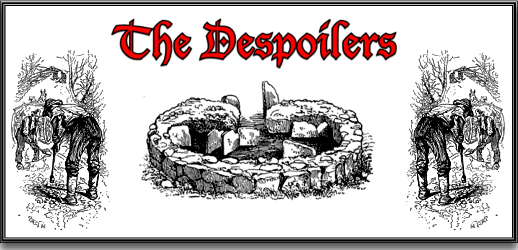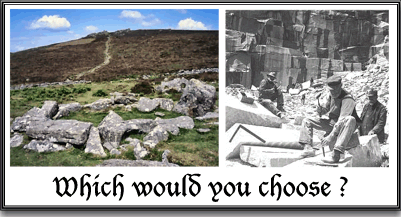
If you read any archaeological book on the Bronze Age you will be certain to find a reference to Dartmoor, be it the hut circles, reaves, or ritual monuments. One of the reasons for this is that due to its climate and geography Dartmoor has never been extensively farmed, therefore what antiquities there were still remain in-situ. At least that is the theory and to some extent it is true but read any of the accounts of the early antiquarians and you will see mention of the ‘despoiled’ remains or ‘lost’ relics, these refer to cases where prehistoric features have been decimated for their stone. Look at any map of Dartmoor and you will see miles of stone walls, gateposts, roads and buildings, all these were built of granite. Then consider that if a few hundred years ago you were building such structures and had the choice of either splitting, shaping, and hauling the stone or simply taking the handy granite stone from a nearby hut circle, reave or cairn what would you do? That is why although there are still many pre-historic remains on the moor there are hundreds that have disappeared due to the work of the despoilers who in ignorance or laziness took the easy option.

In 1928 the prolific Eden Phillpotts wrote a book called ‘A West Country Sketch Book’ and in it he describes how when out walking he met a farmer and his son who in no uncertain terms told him their views on ‘despoiling’ the prehistoric remains on the moor. I make no excuse for extracting some of the story verbatim from the book as it succinctly presents the moorman’s idealology.
“… Less, perhaps, than the Neolithic does a modern Moor-man value the significance of hills and forests; for the Stone folk saw their gods in the thunder-cloud and the rock idol; rivers, lightening, and tempest were the objects of their natural religion; but to-day these things waken no inspiring thought in a rural mind, and the vision of the dwellers in the desert, despite all that has happened since, is probably less fine than that of the vanished hero whose ashes were laid with lamentation in the mountain-side.
On a day gone I sat here by these eternal stones and watched night huddle them to her bosom under a sky of tender colour fading upon the west by gradations of red-gold and green. Great hills and great mists rolled under the gloaming; at hand the rocks of the circle, some still upright, some bent awry by burden of time, some fallen in the heath, were clustered darkly together – like strange beings of another world, sprung from earth at a signal, to keep tryst, rehearse their adventures, and part again.
But it was not these stones that I brought to life; they brought life to me, and among them moved suddenly two grey things – one tall and straight, one humped and shrunken. I heard the mumble of them, and they emerged from the circle and came toward me, and aged priest of the earth and his acolyte, clad in vestments of corduroy, with the badges of their worship on their shoulders.
No sympathy had this farmer and his son with the “old men” and their stone memorials. They were come through the circle from their working-place far off, and the sight of these fine masses of granite, ready to hand but needing little fabrication to fit them for a wall or doorstep, lintel, or gate-post, wakened their greed and anger.
I spoke with them not knowing their mood and desiring to see whether there lurked in the mind of either some feeling for the past. Where-upon they displayed – no lack of feeling indeed; but it was inspired by the requirements of the present. A muddled sense of right and an active consciousness of injury appeared in the old man. His son said little but grunted affirmation to the speeches of his father. The younger was tall, with a fine body, and a little head perched atop of a splendid neck; the elder wore a grizzled beard, and was so round in the back that it fluttered to his navel as he poked forward.
“A fine circle, master,” I said to the old man.
“Damn the circle,” he answered, “T’wouldn’t be a fine circle long if us had our rights!”
“How’s that?”
“Granite is granite, ban’t it? And ’tis very well known us Venwill (venville) tenants have a proper right to it. And what do it matter because they ‘old men’ stuck it here? They just done it, and ’tis ours by right and justice, and now a lot of dog-in-the-manger fools, who come up over once a month o’ Sundays, must needs knock their heads together; and the order goes forth we ban’t to touch this stone nor yet that stone; and they grumble if we so much as split a rock or cart a boulder from the river. And all our own, mind you – all by law belongs to us – like the fuzz and the peat and everything. The wonder is that we be allowed to cut rexens (rushes) or take a trout from the stream!”
“There’s any amount of granite, surely, without knocking down these grand old things?”
“You do ‘feather and tear’ work for a month and then you’ll think different! Lots of granite no doubt – so many lumps of granite as there be mumpheads in Plymouth – but why shouldn’t us use these here brave bits and save our sweat and our time? Ban’t our time, as be money and food, more to us than the time of these zanies, what haven’t got nothing better to do than bleat about stones? Not a ’roundy pound’ (hut circle) must be touched, and not one of the old rows, or walls or nothing. And all our own, mind you! They ‘old men’ picked the best stone for their needs and none troubled them, for ’twas a long time ago afore this here blasted protection society got fussing on the moor; and we be worse off than them heathen savages; for they was free to do what they pleased and we ban’t. And if they dead folk could take what stones they liked, surely to God hard-working men nowadays did aught to be allowed to? And if us had the pluck of a partridge and all rose up and went to the Prince of Wales about it, no doubt he’d send the meddlesome toads about their business.”
“There’s a chap here and there helps himself and nothing’s said,” declared the younger man.
“Because nothings known,” answered his father. “And he’s right, and I deny ’em and defy ’em; and I won’t say yet but they don’t find these gert stones shifted some morning. For if a man haven’t no right to his own ’tis a pity! But the law’s gone so rotten nowadays that ’tis a question whether we’m right to breathe without axing (asking) policeman fust.”
“These things bring people up here and set money moving,” I suggested.
“Bother the people! us don’t want ’em. Me and my son and my son’s wife don’t want ’em. They come poking in our place, as if we was a public house, just because ’tis terrible out ‘o the way and they want to hear their own voices. I don’t hold with it and more don’t my son…”
…Then he hobbled away into the darkness, and left me to re-order my thought and re-adjust emotion. My attitude, unlike the labourer’s, was one of obligation to those who had arrested the destruction of the old stones. For they are very good to see and think upon; this granite that vanished hands dragged hopefully to build a home, or sadly to mark a grave, may well be suffered to stand; and since “Time, which antiquates antiquities, and hath an art to make dust of all things, hath yet spared these minor monuments,” we may do the like and cherish the old stones, so harmonious, so solemn and so still, that link us yet with the vanished ones, who played their part in the morning of days,” pp 52 – 62.
The following report appeared in the press dated the 12th of December 1896 and serves to show that it was not just the moor farmers who were to blame for destroying the ancient monument of Dartmoor:
“Much indignation has been caused among those interested in the preservation of existing memorials of a past age by the recent discovery of Exeter antiquaries that a number of interesting Druidical remains on and around Dartmoor had been destroyed, notably one that was known as the stone avenue at Bel tor corner on Sherberton Common. Investigation being made it was found that the demolition of this relic, as well as the partial destruction of some of the “hut circles” which abound on Dartmoor, was the work of the contractors of the Newton Rural District Council, who had smashed the stones into fragments for the purpose of repairing the surface of the roads. It was subsequently ascertained that “hut circles” and “menhirs” in other places had also completely disappeared, the loss of these monuments of early British life being, of course, irreparable. The matter was taken up by the various societies, and representations were made to the Newton Council, with the result that the chairman of that body has now intimated to one of the correspondents that the surveyor to the council has been instructed to see that nothing of the kind shall be again allowed to occur.”
Another newspaper report from the 23rd of January 1911 stated:
“… A contractor employed by the Okehampton Rural District Council for the repair of the roads recently removed a number of stones from and ancient monument known as the King’s Oven. When attention was called to this the Council, while agreeing that the contractor ought not to have done it, suggested that the Duchy should bear the cost of restoring the stones to there place…The council decided the stones should be replaced.”
In August of 1924 there were still problems as can be seen from this report in The Times:
“In consequence of the continued disappearance of stones from the prehistoric hut circles on Dartmoor, Mr Struben, the owner of Spitchwick Manor has threatened the Newton Abbot Rural District Council with legal proceedings. He states that stones have been taken from the prehistoric remains at Dartmeet and that the probability is that they have been used for repairing roads.
The contractors to the County Council and rural district councils have had strict instructions that these remains must not be disturbed, and they state that the instructions have been carefully carried out. The rural district council yesterday decided to take steps to impress on the contractors and their workmen the importance of leaving these relics undisturbed“.

Eden Phillpotts, 1928 A West Country Sketch Book, Hutchinson & Co.. London.
 Legendary Dartmoor The many aspects past and present of Dartmoor
Legendary Dartmoor The many aspects past and present of Dartmoor
